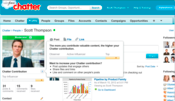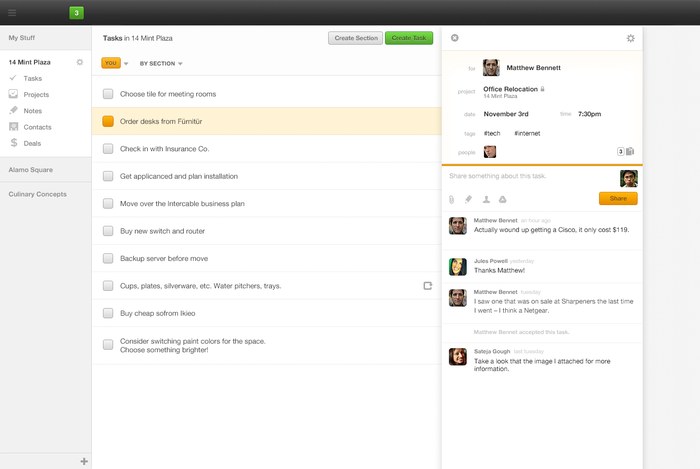Social Task Management Tools Gain CloutSocial Task Management Tools Gain Clout
Constellation Research sees social software for getting work done as an important emerging capability, within broader platforms like IBM Connections and more focused tools like Do.com and Asana.


Enterprise Social Networks: Must-Have Features Guide
Enterprise Social Networks: Must-Have Features Guide (click image for larger view and for slideshow)
When it comes to getting work done, social task management products take collaboration beyond the limits of ad hoc sharing through status and file posts, according to a report from Constellation Research analyst Alan Lepofsky.
"Getting Work Done With Social Task Management" is the first of a planned series of reports focused on defining the category. There's no ranking of vendors here, although that's next. "With this one, I just wanted to show that there is this market," Lepofsky said--a market that's distinct from the broader enterprise social software market. Any social collaboration tool can be used for task or project coordination in the sense that a status post or blog entry can be one way of giving a progress report. However, social task management (STM) software groups social interactions around tasks, and tasks can be associated with deadlines, progress milestones, and other structured data for project tracking.
As defined by Lepofsky, STM includes standalone products like Do.com (from Salesforce.com) and Asana (known for its connection to Facebook), as well as enterprise social networking platforms like IBM Connections with strong task management functionality, and products like Wrike that can be used standalone but also integrate well with enterprise social platforms like Jive.
[ For more insight on collaboration in the enterprise, read What Collaboration Can And Can't Fix. ]
The new focus on social software for getting work done was one of the themes of the Enterprise 2.0 conference in June (since rebranded E2 Social), and Lepofsky also discussed it there. In fact, it's something he has seen as an emerging trend for some time, and he's been studying it intensely for the past several months.
Lepofsky suggests the following three broad categories of products:
-- Standalone: AtTask, Asana, Basecamp, Do, Mavenlink, Producteev, Rule, Strides, and TeamBox.
-- Integrated: Goshido, Neodesic, SAP StreamWork, Sparqlight, and Wrike.
-- Social business platforms with embedded task management: Clearvale, HyperOffice, Huddle, IBM Activities, Jive, Podio, and Traction TeamPage.
"The vendors were all very defensive about where they were put," Lepofsky said. "I tried to explain I wasn't saying one is better than the other." That is, he is not necessarily arguing that platforms are better than standalone products (or vice versa), although he tries to explain the tradeoffs. Those he classifies as standalone tend to have rich feature sets and functionality, with frequent updates, whereas the pace of improvement of IBM Activities might tend to be slower because it's part of the IBM Connections platform. On the other hand, IBM Activities benefits from all the ways it can be used in combination with IBM's broad suite of collaboration software. IBM probably has the most pieces of the puzzle, and as Lepofsky pointed out, "They have a lot of pivot points between them all."
Where the IBM solution gets really cool, Lepofsky said, is for a team conducting a project meeting using IBM web conferencing technology and assigning tasks in IBM Activities as the meeting goes on, with the tasks also associated with the record for the meeting.
Lepofsky is also a pretty big fan of Podio, a startup that was acquired by Citrix in April. While not as high-profile as IBM Connections, Podio is an accessible social software platform in which task management can be organized through user-defined apps. By providing an easy-to-use form builder, Podio makes it easy to start with a generic template and add a field or two that might be required for a specific project.
Jive Software also has some native task management capabilities in its enterprise social networking software, but leaves room for products like Wrike to improve upon it, Lepofsky said.
Meanwhile, SAP argues that StreamWork should be considered a platform, and that it integrates well into other platforms. Lepofsky judged it to be more in the class of products that add a layer of social task management on top of other platforms and applications, including SAP's own products.
Whether the STM capabilities of AtTask should be classified as standalone also depends on your frame of reference. AtTask Teamhome is a social collaboration component of a broader project management toolset, so it's only standalone in the sense of not being part of an enterprise social networking platform.

Salesforce.com's Do.com is one of the standalone social task managers.
Many of the task-focused startups have focused less on traditional enterprise qualities like scalability and integration than on the kind of simplicity that would appeal to consumers or the small to midsize business (SMB) market. That includes Asana as well as Do (which was created by a team that Salesforce.com acquired and has allowed to operate relatively independently). "The way they've explained it is it's not so much SMB versus enterprise as that they're going after small usage, by which I mean a typical project will have 10 to 25 people," Lepofsky said. In other words, a company may have thousands or tens of thousands of employees, but the scale of collaboration around a task or project will still tend to be a relatively small, tight group.
On the other hand, another way these tools differ from traditional project management tools is that membership in the collaboration group need not be limited to those who are assigned tasks related to a project. Lepofsky explained, "You might have a dozen people assigned tasks, but then other people put into that workspace just to monitor." For example, a sales people might use the tool to monitor the progress of an engineering team's work on a new product. "That's a really neat thing and very different from traditional task management."
Lepofsky recommends that firms interested in social task management start by looking at their existing portfolio of collaboration products, which may have STM features already embedded or on their near-term product roadmap. Alternately, look at STM products that will integrate with your existing social collaboration platform. Good candidates for pilot project use of STM include engineering, product development, and marketing groups, according to Lepofsky. Plan to measure project success on metrics including time saved, improved knowledge sharing, and better employee job satisfaction.
Follow David F. Carr on Twitter @davidfcarr. The BrainYard is @thebyard and facebook.com/thebyard
Social media make the customer more powerful than ever. Here's how to listen and react. Also in the new, all-digital The Customer Really Comes First issue of The BrainYard: The right tools can help smooth over the rough edges in your social business architecture. (Free registration required.)
About the Author
You May Also Like






